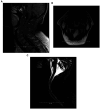Case report: Transition from anti-CD20 therapy to inebilizumab for 14 cases of neuromyelitis optica spectrum disorder
- PMID: 38689876
- PMCID: PMC11060151
- DOI: 10.3389/fneur.2024.1352779
Case report: Transition from anti-CD20 therapy to inebilizumab for 14 cases of neuromyelitis optica spectrum disorder
Abstract
Neuromyelitis optica spectrum disorder (NMOSD) is a rare autoimmune disorder of the central nervous system characterized by recurrent, disabling attacks that affect the optic nerve, spinal cord, and brain/brainstem. While rituximab, targeting CD20-positive B-cells, is used as an off-label therapy for NMOSD, some patients continue to exhibit breakthrough attacks and/or adverse reactions. Inebilizumab, a humanized and glycoengineered monoclonal antibody targeting CD19-positive B-cells, has been FDA approved for the treatment of NMOSD in adult patients who are anti-aquaporin-4 (AQP4) antibody positive. Given the limited real-world data on the efficacy and safety of inebilizumab, especially in those transitioning from rituximab, a retrospective chart review was conducted on 14 NMOSD patients from seven centers. Of these, 71.4% (n = 10) experienced a combined 17 attacks during rituximab treatment, attributed to either breakthrough disease (n = 10) or treatment delay (n = 7). The mean duration of rituximab treatment was 38.4 months (3.2 years). Notably, no subsequent attacks were observed during inebilizumab treatment [mean duration of inebilizumab treatment was 19.3 months (1.6 years)], underscoring its potential as an effective treatment for NMOSD. Our data suggest that inebilizumab provides clinical benefit with effective disease control and a favorable safety profile for patients transitioning from rituximab.
Keywords: aquaporin-4 antibody; case report; clinical outcome; inebilizumab; neuromyelitis optica spectrum disorder; rituximab; treatment transition.
Copyright © 2024 Osborne, Romanow, Hemphill, Zarif, DeAngelis, Kaplan, Oh, Pinkhasov, Patterson and Levy.
Conflict of interest statement
BO is currently compensated as a speaker for Alexion, Genentech, and Horizon Therapeutics (now Amgen); has received personal compensation from Biogen as a speaker; currently receives royalties from UpToDate for chapters authored on optic neuritis; has received personal compensation for participation in advisory boards from both Alexion and Horizon Therapeutics. MH has received research support from Sanofi, Roche, and Novartis; has served on scientific advisory boards for Horizon Therapeutics, Alexion, EMD Serono, and Roche/Genentech; currently a speaker for Horizon Therapeutics (now Amgen), Alexion, EMD Serono, Biogen, and TG Therapeutics. MZ currently receives personal compensation as a speaker for Horizon Therapeutics (now Amgen) and Biogen. TD has received personal compensation as a speaker for Teva; currently receives personal compensation as a speaker for Horizon Therapeutics (now Amgen) and Biogen. TK has received personal compensation as a speaker for Horizon Therapeutics, Biogen, TG Therapeutics, and EMD Serono; for participating in advisory boards for Horizon Therapeutics, TG Therapeutics, Sanofi, Genentech, Bristol Myers Squibb, Octave Bio, and Genzyme. UO has received consulting fees from Horizon Therapeutics and Genentech. ML currently receives personal compensation for advising the following companies: Alexion, Horizon Therapeutics (now Amgen), Genentech/Roche, UCB, Sanofi, and Mitsubishi. Through Mass General, ML received grants from Alexion, Horizon, Genentech, Roche, UCB, and Sanofi for research projects. JP and KP are employees of Horizon Therapeutics and own stock. The remaining author declares that the research was conducted in the absence of any commercial or financial relationships that could be construed as a potential conflict of interest. The authors declare that the N-MOmentum trial was funded by MedImmune/AstraZeneca and Viela Bio (now part of Horizon Therapeutics). The funder had the following involvement in the study: Horizon Therapeutics (now Amgen) supported the development of this manuscript and provided data analyses according to the direction of the authors.
Figures

Similar articles
-
Inebilizumab: A Review in Neuromyelitis Optica Spectrum Disorder.CNS Drugs. 2022 Oct;36(10):1133-1141. doi: 10.1007/s40263-022-00949-7. Epub 2022 Sep 7. CNS Drugs. 2022. PMID: 36070074 Free PMC article. Review.
-
Inebilizumab for treatment of neuromyelitis optica spectrum disorder in patients with prior rituximab use from the N-MOmentum Study.Mult Scler Relat Disord. 2022 Jan;57:103352. doi: 10.1016/j.msard.2021.103352. Epub 2021 Oct 26. Mult Scler Relat Disord. 2022. PMID: 35158461 Clinical Trial.
-
Inebilizumab for treatment of neuromyelitis optica spectrum disorder.Neurodegener Dis Manag. 2021 Oct;11(5):341-352. doi: 10.2217/nmt-2021-0017. Epub 2021 Sep 6. Neurodegener Dis Manag. 2021. PMID: 34486379
-
[Efficacy and Safety of Inebilizumab, an Anti-CD19 Monoclonal Antibody, for the Treatment of Neuromyelitis Optica Spectrum Disorder: Based on the N-MOmentum Trial].Brain Nerve. 2024 Oct;76(10):1153-1160. doi: 10.11477/mf.1416202751. Brain Nerve. 2024. PMID: 39370840 Review. Japanese.
-
Safety and efficacy of inebilizumab for the treatment of neuromyelitis optica spectrum disorder: end-of-study results from the open-label period of the N-MOmentum trial.Lancet Neurol. 2024 Jun;23(6):588-602. doi: 10.1016/S1474-4422(24)00077-2. Lancet Neurol. 2024. PMID: 38760098 Clinical Trial.
References
Publication types
Grants and funding
LinkOut - more resources
Full Text Sources

